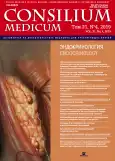Medically induced hypoglycemia: focus on medications not included in the group of antihyperglycemic medications
- Authors: Ostroumova O.D.1,2, Akimova E.S.2, Kochetkov A.I.1, Pereverzev A.P.1
-
Affiliations:
- Russian Clinical and Research Center of Gerontology - Pirogov Russian National Research Medical University
- A.I.Yevdokimov Moscow State University of Medicine and Dentistry
- Issue: Vol 21, No 4 (2019)
- Pages: 59-56
- Section: Articles
- URL: https://journals.rcsi.science/2075-1753/article/view/96836
- DOI: https://doi.org/10.26442/20751753.2019.4.190196
- ID: 96836
Cite item
Full Text
Abstract
Full Text
##article.viewOnOriginalSite##About the authors
Olga D. Ostroumova
Russian Clinical and Research Center of Gerontology - Pirogov Russian National Research Medical University; A.I.Yevdokimov Moscow State University of Medicine and Dentistry
Email: ostroumova.olga@mail.ru
D. Sci. (Med.), Full Prof. Moscow, Russia
Elizaveta S. Akimova
A.I.Yevdokimov Moscow State University of Medicine and Dentistry
Email: akimova.liza.96@gmail.com
Student Moscow, Russia
Aleksei I. Kochetkov
Russian Clinical and Research Center of Gerontology - Pirogov Russian National Research Medical UniversityCand. Sci. (Med.) Moscow, Russia
Anton P. Pereverzev
Russian Clinical and Research Center of Gerontology - Pirogov Russian National Research Medical UniversityCand. Sci. (Med.) Moscow, Russia
References
- Дедов И.И., Шестакова М.В., Викулова О.К. и др. Сахарный диабет в Российской Федерации: распространенность, заболеваемость, смертность, параметры углеводного обмена и структура сахароснижающей терапии по данным Федерального регистра сахарного диабета, статус 2017 г. Сахарный диабет. 2018; 3 (21): 144-59. doi: 10.14341/DM9686
- Сычев Д.А. Полипрагмазия в клинической практике: проблема и решения. Учебное пособие для врачей. СПб., 2016.
- Vue M.H, Setter S.M. Drug-Induced Glucose Alterations Part 1: Drug-Induced Hypoglycemia. Diabetes Spectrum 2011; 24 (3): 171-7. DOI: 10.2337
- Pandit M, Burke J, Gustafson A et al. Drug-induced disorders of glucose tolerance. Ann Intern Med 1993; 7: 529-39.
- Дедов И.И., Шестакова М.В., Майоров А.Ю. Алгоритмы специализированной медицинской помощи больным сахарным диабетом. 8-й выпуск. Сахарный диабет. 2017; 20 (1S): 1-121.
- Helms K, Kelley K. Drug-Induced Hypoglycemia, Hypoglycemia - Causes and Occurrences [online]. 2011; р. 113-30. http://cdn.intechopen.com/pdfswm/21469.pdf
- Zammit N.N, Frier B.M. Hypoglycemia in type 2 diabetes. Pathophysiology, frequency, and effects of different treatment modalities. Diabetes Care 2005; 28 (12): 2948-61.
- Murad M, Coto-Yglesias F, Wang A et al. Drug-induced hypoglycemia: a systematic review. J Clin Endocrinol Metab 2009; 94 (3): 741-5. DOI: 10,1210
- Seltzer H.S. Drug-induced hypoglycemia. A review of 1418 cases. Endocrinol Metab Clin North Am 1989; 18: 163-1833.
- Ioannidis J.P, Lau J. Completeness of safety reporting in randomized trials: an evaluation of 7 medical areas. JAMA 2001; 285: 437-4434.
- База данных неблагоприятных побочных реакций ВОЗ VigiBase. http://www.vigiaccess.org (Дата обращения: 17.12.2018).
- Ferriere M, Lachkar H, Richard J.L et al. Captopril and insulin sensitivity [letter]. Ann Intern Med 1985; 102: 134.
- White J. The contribution of medications to hypoglycemia unawareness. Diabetes Spectrum 2007; 20 (2): 77-80.
- White J.R, Campbell R.K. Dangerous and common drug interactions in patients with diabetes mellitus. Endocrinol Metab Clin North Am 2000; 29: 789-802.
- White J.R, Campbell R.K. Drug-drug and drug-disease interactions and diabetes. Diabetes Educ 1995; 21: 283-9.
- Product Information: InnoPran XL oral capsules, propranolol hydrochloride oral capsules. GlaxoSmithKline 2010.
- Ma R.C.W, Kong A.P.S, Chan N et al. Drug-induced endocrine and metabolic disorders. Drug Saf 2007; 30: 215-45.
- Thomson Reuters Healthcare: Micromedex Healthcare Series. Greenwood Village, Colo., Thomson Reuters Healthcare, 2011. 11.12.2018. http://www.micromedex.com/products/hcs
- Product Information: Pentam 300 IV, IM injection, pentamidine isethionate IV, IM injection. American Pharmaceutical Partners 2008.
- Product Information: Nebupent inhalation solution, pentamidine isethionate inhalation solution. American Pharmaceutical Partners 2018.
- Cryer P.E, Axelrod L, Grossman A.B et al. Evaluation and management of adult hypoglycemic disorders: an Endocrine Society clinical practice guideline. J Clin Endocrinol Metab 2009; 94: 709-28.
- Maeda N, Tamagawa T, Niki I et al. Increase in insulin release by rat pancreatic islets by quinolone antibiotics. Br J Pharmacol 1996; 117: 372-6.
- Frothingham R. Glucose homeostasis abnormalities associated with use of gatifloxacin. Clin Infect Dis 2005; 41(9): 1269-76.
- Gajjar D, LaCreta F, Kollia G et al. Effect of multiple-dose gatifloxacin or ciprofloxacin on glucose homeostasis and insulin production in patients with noninsulin-dependent diabetes mellitus maintained with diet and exercise. Pharmacotherapy 2000; 20 (6): 76-86.
- Park-Wyllie L, Juurlink D, Kopp A et al. Outpatient gatifloxacin therapy and dysglycemia in older adults. N Engl J Med 2006; 354 (25): 1352-61.
- Product Information: Tequin oral tablets, injection, gatifloxacin oral tablets, injection. Bristol-Myers Squibb Company, 2011.
- Greenberg A.L, Decerbo M, Fan J. Gatifloxacin therapy associated with hypogly-cemia. Clin Infect Dis 2005; 40: 1210-1.
- Goldfine A.B, Fonseca V, Jablonski K.A et al. The effects of salsalate on glycemic control in patients with type 2 diabetes: a randomized trial. Ann Intern Med 2005; 152: 346-57.
- Hundal R.S, Petersen K.F, Mayerson A.B et al. Mechanism by which high-dose aspirin improves glucose metabolism in type 2 diabetes. J Clin Invest 2002; 109: 1321-6.
- Product Information: Indocin intravenous injection, indomethacin intravenous injection. Lundbeck Inc, 2010.
- Hosono S, Ohno T, Kimoto H et al. Reduction in blood glucose values following indomethacin therapy for patent ductus arteriosus. Pediatr Int 1999; 41 (5): 525-8.
- Product Information: Qualaquin oral capsules, quinine sulfate oral capsules. AR Scientific Inc, 2010.
- Field J.B, Williams H.E, Mortimore G.E. Studies on the mechanism of ethanol-induced hypoglycemia. J Clin Invest 1962; 42 (4): 497-506.
- Weathermon R, Crabb D.W. Alcohol and medication interactions. Alcohol Res Health 1999; 23 (1): 40-54.
- Cryer P.E, Davis S.N, Shamoon H. Hypoglycemia in diabetes. Diabetes Care 2003; 26 (3): 1902-12.
Supplementary files






